Читать книгу Surface Displacement Measurement from Remote Sensing Images - Olivier Cavalie - Страница 24
1.2.8. Sentinel-1
ОглавлениеSentinel-1 belongs to the Copernicus European program, but the conception and operations were delegated to the European Space Agency. This is the first long-term program that has really taken InSAR as an operational objective, with a very small orbital tube of 100 m radius and 12-day repeat pass, which comes down to six days with two satellites (S1A and S1B), and possibly four days with three satellites operating, as Sentinel-1C and 1D have already been authorized. Sentinel-1A and 1B were launched in April 2014 and April 2016, respectively.
In contrast to the Envisat mission, a focus on a consistent archive is of prime interest and most emerged land is monitored, with the maximum capacity of any system operating in Europe. There are four basic modes: extra wide (EW) ScanSAR of 400 km in five subswaths, interferometric wide (IW) ScanSAR of 240 km in three subswaths, six stripmap modes about 80 km each, and a wave mode (20 km images every 200 km at incidences of 23° and 36°) for open ocean. IW is the privileged mode for land, avoiding gaps, and sometimes uses single-polarization VV, but most of the time dual polarization has been used since Sentinel-1B was launched.
IW is the main operational mode: the ScanSAR mode includes the TOPS mode successfully tested on TerraSAR-X (see section 1.2.5). Agility for the antenna is introduced along-track (azimuth) from backward to forward, for each burst of about 20 km. Each IW subswath consists of 9–10 bursts delivered with their own auxiliary parameters. Each burst is precisely synchronized between each acquisition so that interferometry is always possible.
The next two Sentinel-1 satellites, S1C and S1D, are quite similar to S1A and S1B and are in a building/storage phase untill launch, which will probably occur in 2022/2023 and 2024/2025, with the same operating modes for SAR images, but with increased capacity for maritime surveillance (AIS payload). This will hopefully insure continuous SAR data from October 2014 to beyond 2035, which has never happened in a space program to date. Hopefully, the system will operate with three satellites and four-day repeat pass interferometry on a large scale, at least over Europe.
Some limitations of the mission with regard to interferometry: In contrast to stripmap, the IW mode introduces additional complexity with regard to interferometry: to avoid phase jumps in the final image, very precise coregistration and phase examination in burst overlaps must be achieved. Products do not always cover the same area on the ground and splitting/gathering bursts in several products may be necessary.
Data access: All Sentinel-1 products are freely accessible via the Copernicus hub (https://scihub.copernicus.eu/dhus/) or on mirror sites such as PEPS (https://peps.cnes.fr/). In contrast to the Copernicus hub, PEPS do not archive RAW data, but only processed single-look complex (SLC), ground range detected (GRD) and wave mode data. The archive began on October 3, 2014. Other products directly derived from the Sentinel-1 data and showing ground motion for European land are freely available through a Copernicus service (https://www.copernicus.eu/en/events/events/onlineeuropean-ground-motion-service-copernicus).
